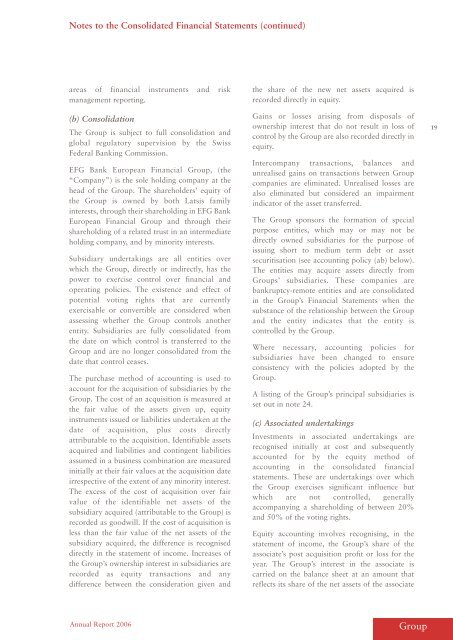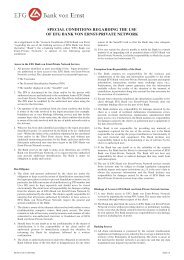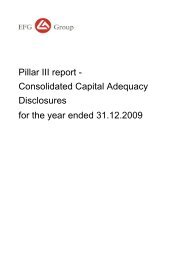Annual Report - EFG Bank Group
Annual Report - EFG Bank Group
Annual Report - EFG Bank Group
You also want an ePaper? Increase the reach of your titles
YUMPU automatically turns print PDFs into web optimized ePapers that Google loves.
Notes to the Consolidated Financial Statements (continued)<br />
areas of financial instruments and risk<br />
management reporting.<br />
(b) Consolidation<br />
The <strong>Group</strong> is subject to full consolidation and<br />
global regulatory supervision by the Swiss<br />
Federal <strong>Bank</strong>ing Commission.<br />
<strong>EFG</strong> <strong>Bank</strong> European Financial <strong>Group</strong>, (the<br />
“Company”) is the sole holding company at the<br />
head of the <strong>Group</strong>. The shareholders’ equity of<br />
the <strong>Group</strong> is owned by both Latsis family<br />
interests, through their shareholding in <strong>EFG</strong> <strong>Bank</strong><br />
European Financial <strong>Group</strong> and through their<br />
shareholding of a related trust in an intermediate<br />
holding company, and by minority interests.<br />
Subsidiary undertakings are all entities over<br />
which the <strong>Group</strong>, directly or indirectly, has the<br />
power to exercise control over financial and<br />
operating policies. The existence and effect of<br />
potential voting rights that are currently<br />
exercisable or convertible are considered when<br />
assessing whether the <strong>Group</strong> controls another<br />
entity. Subsidiaries are fully consolidated from<br />
the date on which control is transferred to the<br />
<strong>Group</strong> and are no longer consolidated from the<br />
date that control ceases.<br />
The purchase method of accounting is used to<br />
account for the acquisition of subsidiaries by the<br />
<strong>Group</strong>. The cost of an acquisition is measured at<br />
the fair value of the assets given up, equity<br />
instruments issued or liabilities undertaken at the<br />
date of acquisition, plus costs directly<br />
attributable to the acquisition. Identifiable assets<br />
acquired and liabilities and contingent liabilities<br />
assumed in a business combination are measured<br />
initially at their fair values at the acquisition date<br />
irrespective of the extent of any minority interest.<br />
The excess of the cost of acquisition over fair<br />
value of the identifiable net assets of the<br />
subsidiary acquired (attributable to the <strong>Group</strong>) is<br />
recorded as goodwill. If the cost of acquisition is<br />
less than the fair value of the net assets of the<br />
subsidiary acquired, the difference is recognised<br />
directly in the statement of income. Increases of<br />
the <strong>Group</strong>’s ownership interest in subsidiaries are<br />
recorded as equity transactions and any<br />
difference between the consideration given and<br />
<strong>Annual</strong> <strong>Report</strong> 2006<br />
the share of the new net assets acquired is<br />
recorded directly in equity.<br />
Gains or losses arising from disposals of<br />
ownership interest that do not result in loss of<br />
control by the <strong>Group</strong> are also recorded directly in<br />
equity.<br />
Intercompany transactions, balances and<br />
unrealised gains on transactions between <strong>Group</strong><br />
companies are eliminated. Unrealised losses are<br />
also eliminated but considered an impairment<br />
indicator of the asset transferred.<br />
The <strong>Group</strong> sponsors the formation of special<br />
purpose entities, which may or may not be<br />
directly owned subsidiaries for the purpose of<br />
issuing short to medium term debt or asset<br />
securitisation (see accounting policy (ab) below).<br />
The entities may acquire assets directly from<br />
<strong>Group</strong>s’ subsidiaries. These companies are<br />
bankruptcy-remote entities and are consolidated<br />
in the <strong>Group</strong>’s Financial Statements when the<br />
substance of the relationship between the <strong>Group</strong><br />
and the entity indicates that the entity is<br />
controlled by the <strong>Group</strong>.<br />
Where necessary, accounting policies for<br />
subsidiaries have been changed to ensure<br />
consistency with the policies adopted by the<br />
<strong>Group</strong>.<br />
A listing of the <strong>Group</strong>’s principal subsidiaries is<br />
set out in note 24.<br />
(c) Associated undertakings<br />
Investments in associated undertakings are<br />
recognised initially at cost and subsequently<br />
accounted for by the equity method of<br />
accounting in the consolidated financial<br />
statements. These are undertakings over which<br />
the <strong>Group</strong> exercises significant influence but<br />
which are not controlled, generally<br />
accompanying a shareholding of between 20%<br />
and 50% of the voting rights.<br />
Equity accounting involves recognising, in the<br />
statement of income, the <strong>Group</strong>’s share of the<br />
associate’s post acquisition profit or loss for the<br />
year. The <strong>Group</strong>’s interest in the associate is<br />
carried on the balance sheet at an amount that<br />
reflects its share of the net assets of the associate<br />
<strong>Group</strong><br />
19





